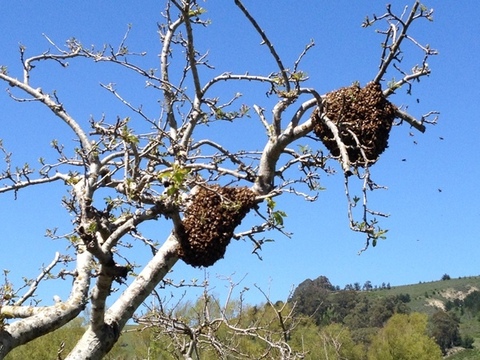Bee swarms, where the old queen and about half a colony leave a hive looking for a new home, are common in spring. If you or neighbors have bees, expect to see clusters of bees a few hundred yards from the old hive. The cluster is the departed group, hanging together, usually in a tree, waiting for the scout bees to lead them to a suitable new home. This is the best time to collect and rehouse the swarm.
Bee clusters in one of our old apple trees, waiting for their scouts to find a new home. Thankfully apple trees are easy to climb. Tell your beekeeper if they need to bring a ladder!
Swarming bees, especially in northern California, where they are likely to be mild-mannered European honey bees, are docile unless provoked, so don’t panic if a mass of bees hums past you. They are not protecting their brood, as they would in a hive, and they are not yet hungry.
The scout bees are looking for a secure cavity of between six and ten gallons, with an entrance ideally about ten feet from the ground, such as a hollow tree. They will be attracted by buildings in poor repair - if they set up house in one of your outbuildings, you will need to find an experienced beebuster. Search online for a local beekeeper, looking for those who collect and rehouse swarms. County agricultural offices may be able to help. Do not be tempted by the cheaper option of killing the bees, because the huge mass of bees, comb and honey will rot through your drywall, causing considerable structural damage. An experienced beekeeper will clean the area thoroughly so that no beeswax remains, attracting future bee scouts looking for a home. And fix that entrance hole!
Wedding Bees from Harley Farms on Vimeo.

